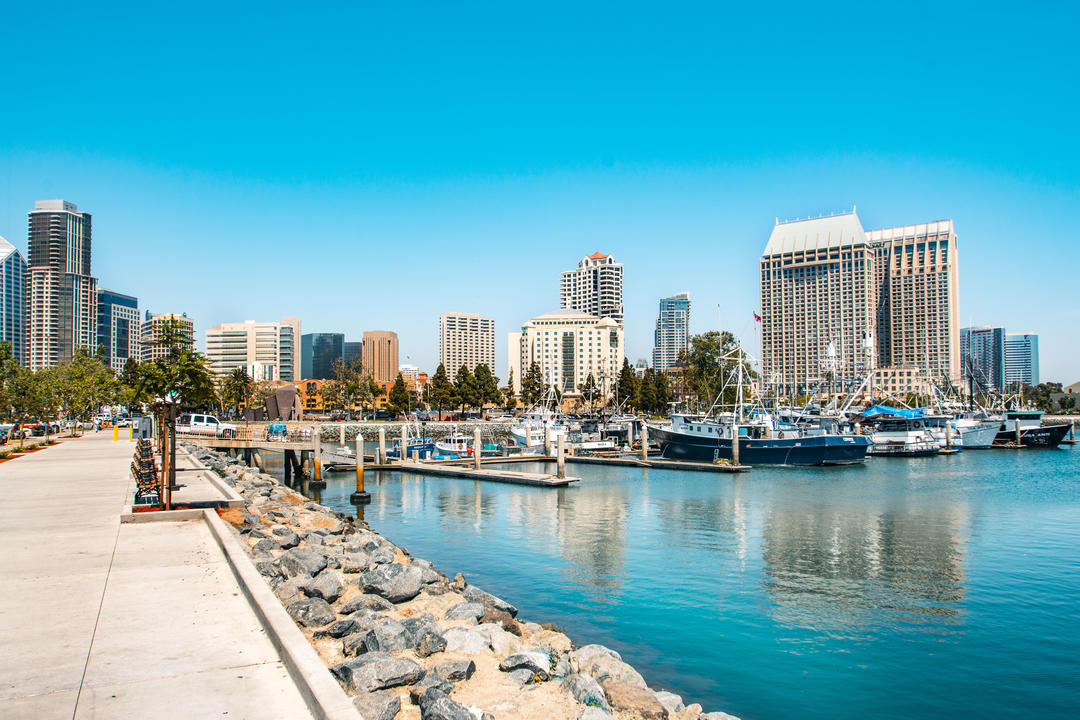Tuna Harbor Basin Mooring Rates (In-Transit & Mooring Permittees)
- Dockage Charges (Permit Holders): 10.5 cents per lineal foot per calendar day
- Dockage Charges (In-Transit Fishing Vessels): $26.25 per day
- Parking Permits: $47.00 per quarter (4 permits for each mooring permittee)
- Additional Parking Permits: $370.00 each per quarter
- Gear Storage: $53.34 per quarter for 100 square feet
Port of San Diego Wharfinger’s office and phone number
619-686-6345 (24/7)
USCG Safety Exam Officer contact information
James Stellflug
Examiner
Office: 619-278-7249
Fax: 619-278-7235
James.B.Stellflug@uscg.mil
Helpful Links
Tuna Harbor Dockside Market (Weekly fish market on Tuna Harbor Pier)
- Fuel Dock & Pump-out locations
- Driscoll’s Wharf
- San Diego Working Fishermen’s Group
- Community Fisheries Network
- San Diego Food System Alliance
- American Albacore Fishing Association
- Fish Safe West (Safety For Commercial Fishing Vessels)
- Fish Safe West - Mandatory Dockside Safety Exams
- California Department of Fish and Wildlife
- California Department of Fish and Wildlife “Final Landings Reports” (Yearly Amounts & Values of Catches at California Ports & Harbors)
Tuna Harbor Basin Stats
- Area includes 5.4 acres of land and 13.1 acres of water designated for commercial fishing purposes
- Dock No. 1: 12 fingers ranging from 50 ft. to 80 ft. in length providing 25 slips with water depths from 13 ft. to 17 ft. (MLLW).
- Dock No. 2: 27 fingers ranging from 30 ft. to 60 ft. in length providing 48 slips with water depths from 12 ft. to 20 ft. (MLLW)
- Dock No. 3: 16 fingers ranging from 40 ft. to 50 ft. in length providing 32 slips with water depths from 17 ft. to 25 ft. (MLLW)
- Total number of slips: 105 (68 in service)
- G Street Mole: 900 lineal feet with water depths from 22 to 32 ft. (MLLW)
- Tuna Harbor Pier: 370 lineal ft. north side; 325 lineal ft. south side with water depths from 13 to 29 ft. (MLLW)
- Fish Market Wharf: 100 lineal ft. with water depths of 11 ft. (MLLW)
Tuna Harbor Basin Amenities
- 110 volt, 30 amp electrical outlets
- Potable water
- Restroom facilities
- Permit Parking
- Offloading Facilities
- 1 crane @ 4,000 lbs. max. cap.
- 2 cranes @800 lbs. max. cap.
- Gear Storage Areas
- Solid waste receptacles
- Secured gates
History of Tuna Harbor
Commercial fishing has a long history at the Port of San Diego. The first cannery opened in 1909 and at one time San Diego was known as “The Tuna Capital of the World” with two of the countries three biggest tuna canneries being based along its Bay. In the 1960’s tuna was the City’s third-largest industry with almost 40,000 employees who caught, sold or processed fish from the major fleet moored at its docks. Today, due to a variety of environmental, regulatory and economic factors the tuna fleet now focuses on the waters of the Western Pacific but fishermen still sail from the Tuna Harbor Basin to catch such species as swordfish, lobster and sea urchins.
Tuna Boat Basin is located in the downtown area of San Diego adjacent to the south side of G Street Mole. Facilities within the basin include Tuna Boat Pier, Fish Harbor Pier, Fish Market Wharf and three floating docks. Tuna Boat pier was constructed in 1977 and extends a distance of approximately 900 ft from the southwest end of G Street Mole. Fish Harbor Pier which was constructed in 1980, is located on the east side of San Diego Bay adjacent to Seaport Village. The pier extends out into the bay a distance of 400 ft and is aligned perpendicular to the shoreline. Fish Market Wharf was constructed in 1971 and is located adjacent to Fish Harbor Pier. This structure is the off-loading facility for Tuna Harbor Basin. The wharf is approx. 100 ft long and 50 ft wide and is equipped with a jib crane. All of these concrete piers were designed for in-transit vessels (vessels that are not permanently home-ported in San Diego Bay) or vessels that are in excess of 90 feet in length. The piers not only provide berthing for larger fishing vessels but are used as an area for the servicing and storage of fishing nets, lobster traps, crab traps and other related equipment.
The three floating docks were built to provide slips for home-ported commercial fishing vessels up to 90 feet in length. Dock No. 1 was built in 1990 and consists of concrete floats filled with polystyrene. Dock No. 2 was constructed in 1983. It consists of a timber deck on plastic tubs. Dock No. 3 was built in 1977 and consists of timber decking supported by plastic tubs or pontoons. Dock No. 3 underwent major improvements in 2003 including replacement of timbers, installation of new pontoons and replacement of steel framing.
